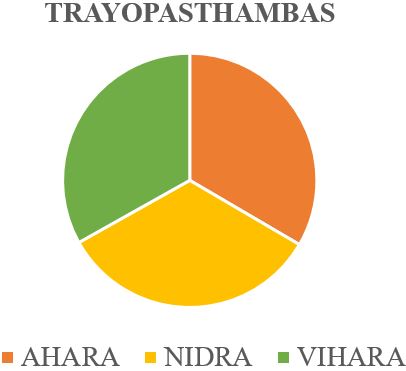Lifestyle Modifications in Anorectal Disorders: A Review
DOI:
https://doi.org/10.21760/jaims.10.2.27Keywords:
Haemorrhoids, Fissure, Fistula, Guda, Arshas, Parikartika, Bhagandara, Pathya, Ahara, ViharaAbstract
Anorectal disorders are the disorders that occurs at the rectum and anal canal which are the terminal parts of intestines. Anorectal disorders, such as haemorrhoids, anal fissures, anorectal abscess, fistulas, rectal prolapse, fecal incontinence are prevalent conditions that creates an agony both physically and mentally, hampers the individual routine and leads to complications if untreated. Lifestyle modifications play a crucial role in managing anorectal disorders, significantly impacting both physical health and quality of life. Evidence suggests that adopting specific lifestyle changes can alleviate symptoms, prevent recurrence, and enhance overall well-being. Studies indicate that fiber supplementation can decrease the incidence of symptoms by up to 50% in haemorrhoids patients.[1] Additionally, adequate hydration is essential; The recommended total daily fluid intake of 3,000 ml for men and of 2,200 ml for women which may help in fiber work effectively to soften the stool.[2] Regular exercise enhances gastrointestinal motility, reducing the likelihood of constipation and associated complications. Ayurveda focuses on lifestyle modifications (Pathya Ahara and Vihara) to stay healthy and manage the diseases effectively. The integration of these changes into daily routines improves long-term health outcomes. This conceptual study is an attempt to throw light on the importance of lifestyle modifications in anorectal disorders for prevention, to improve the recovery and reduce the recurrence.
Downloads
References
Gill SK, Rossi M, Bajka B, et al. Dietary fiber in gastrointestinal health and disease. Nat Rev Gastroenterol Hepatol. 2021;18(2):101–16. doi: 10.1038/s41575-020-00375-4.
Meinders AJ, Meinders AE. Hoeveel water moeten we eigenlijk drinken? [How much water do we really need to drink?]. Ned Tijdschr Geneeskd. 2010;154:A1757. PMID: 20356431. Available from: https://pubmed.ncbi.nlm.nih.gov/20356431/.
Sharma PV. Charaka Samhita, Sutra Sthana. Chapter 25, Verse 45. Varanasi: Chaukhambha Orientalia; 2014. p. 625.
Sharma PV. Sushruta Samhita, Sutra Sthana. Chapter 20, Verse 3. Varanasi: Chaukhambha Vishvabharati; 2018. p. 213.
Foxx-Orenstein AE, Umar SB, Crowell MD. Common anorectal disorders. Gastroenterol Hepatol (N Y). 2014;10(5):294-301. PMID: 24987313; PMCID: PMC4076876.
Makki K, Deehan EC, Walter J, Bäckhed F. The impact of dietary fiber on gut microbiota in host health and disease. Cell Host Microbe. 2018;23(6):705–15. doi: 10.1016/j.chom.2018.05.012. Available from: https://www.sciencedirect.com/science/article/pii/S193131281830266X.
Thursby E, Juge N. Introduction to the human gut microbiota. Biochem J. 2017 Jun 1;474(11):1823–36. doi: 10.1042/BCJ20160510.
Sharma PV. Charaka Samhita, Chikitsa Sthana. Chapter 6-20, Verse 15. Varanasi: Chaukhambha Orientalia; 2014. p. 251.
Fu J, Zheng Y, Gao Y, Xu W. Dietary fiber intake and gut microbiota in human health. Microorganisms. 2022 Dec 18;10(12):2507. doi: 10.3390/microorganisms10122507. PMID: 36557760; PMCID: PMC9787832.
Sharma PV. Charaka Samhita, Vimana Sthana. Chapter 6, Verse 18. Varanasi: Chaukhambha Orientalia; 2014. p. 251.
Sreekumar T. Astangahrdayam, Sutrasthana-1. Chapter 7, Verse 52. 5th ed. Harisree Hospital Publications; p. 51.
Sharma PV. Charaka Samhita, Chikitsa Sthana. Chapter 25, Verse 15. Varanasi: Chaukhambha Orientalia; 2014. p. 251.
Ayusoft. Trayopastambha. Available from: https://ayusoft.ayush.gov.in/trayopastambha/.
Lindam A, Ness-Jensen E, Jansson C, et al. Gastroesophageal reflux and sleep disturbances: A bidirectional association in a population-based cohort study, The HUNT Study. Sleep. 2016 Jul 1;39(7):1421–7. doi: 10.5665/sleep.5976. PMID: 27166240; PMCID: PMC4909624.
Smith RP, Easson C, Lyle SM, et al. Gut microbiome diversity is associated with sleep physiology in humans. PLoS One. 2019 Oct 7;14(10):e0222394. doi: 10.1371/journal.pone.0222394. PMID: 31589627; PMCID: PMC6779243.
Sharma PV. Sushruta Samhita, Chikitsa Sthana. Chapter 6, Verse 8. Varanasi: Chaukhambha Vishvabharati; 2018. p. 331.
Sharma PV. Sushruta Samhita, Chikitsa Sthana. Chapter 8, Verse 54. Varanasi: Chaukhambha Vishvabharati; 2018. p. 357.
Tewari PV. Kasypa Samhita, Khila Sthana. Chapter 4, Verses 102–106. Varanasi: Chaukhambha Viswabharti; 2008. p. 565.
Sharma PV. Sushruta Samhita, Chikitsa Sthana. Chapter 20, Verse 63. Varanasi: Chaukhambha Vishvabharati; 2018. p. 469.
Davani-Davari D, Negahdaripour M, Karimzadeh I, et al. Prebiotics: Definition, types, sources, mechanisms, and clinical applications. Foods. 2019 Mar 9;8(3):92. doi: 10.3390/foods8030092. PMID: 30857316; PMCID: PMC6463098. Available from: https://pmc.ncbi.nlm.nih.gov/articles/PMC6463098/.
Melquiades R, et al. Potential prebiotic effect of fruit and vegetable byproducts flour using in vitro gastrointestinal digestion. Food Res Int. 2020 Nov;137:109354. Available from: https://www.sciencedirect.com/science/article/abs/pii/S0963996920303793.
Sharma PV. Charaka Samhita, Chikitsa Sthana. Chapter 14, Verses 76–88. Varanasi: Chaukhambha Orientalia; 2014. p. 233.
de Freitas M A, et al. Technological and biological properties of buttermilk: A minireview. IntechOpen. 2019 Jun. doi: 10.5772/intechopen.80921.
Kumar S, et al. Takra Prayoga in Arshas. Int Ayurvedic Med J. 2017 Jan;5(1):207-210. ISSN: 2320-5091. Available from: https://www.iamj.in/posts/2017/images/upload/207_210.pdf.
Charles H, Cohen RC. Chronic anal pain: A review of causes, diagnosis, and treatment. Cleveland Clinic J Med. 2022 Jun;89(6):336-343. doi: 10.3949/ccjm.89a.21102.
William C, et al. Sleep and irritable bowel syndrome. International Foundation for Gastrointestinal Disorders. 2020. Available from: https://iffgd.org/wp-content/uploads/178-Sleep-and-IBS-1.pdf.
Suri H, Suri D, Bansal K. Squatting or Western toilet—A review. J Adv Med Dent Scie Res. 2020;8(11):102-104. Available from: https://jamdsr.com/uploadfiles/23VOL8ISSUE11P102-104.20201112115109.pdf.















